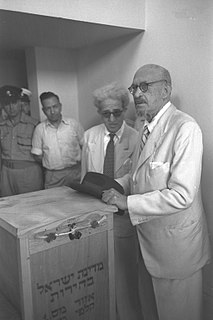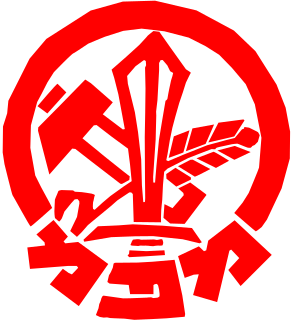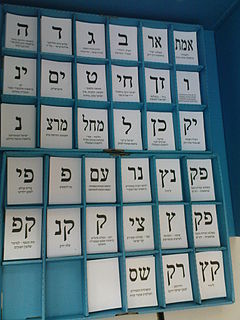
Elections for the second Knesset were held in Israel on 30 July 1951. Voter turnout was 75.1%.
The United Religious Front was a political alliance of the four major religious parties in Israel, as well as the Union of Religious Independents, formed to fight the 1949 elections.
Elections for the fourth Knesset were held in Israel on 3 November 1959. Voter turnout was 81.5%.
Poalei Agudat Yisrael was a trade union and Jewish political party in Poland, and was a minor political party in Israel. It was also known as PAI or PAGI, its Hebrew acronym.
Elections for the sixth Knesset were held in Israel on 2 November 1965. Voter turnout was 85.9%.

Kalman Kahana was a long-serving Israeli politician and journalist, and a signatory of the Israeli declaration of independence. He was the brother of Yitzhak Kahan, former President of the Supreme Court of Israel.

The Alignment is the name of two political alliances in Israel. Each of these Alignment parties later merged into what is now the Israeli Labor Party.

The third government of Israel was formed by David Ben-Gurion on 8 October 1951, more than two months after the elections. His Mapai party formed a coalition with Mizrachi, Hapoel HaMizrachi, Agudat Yisrael, Poalei Agudat Yisrael and the three Israeli Arab parties, the Democratic List for Israeli Arabs, Progress and Work and Agriculture and Development. There were 15 ministers.

The fourth government of Israel was formed by David Ben-Gurion during the second Knesset on 24 December 1952. Ben-Gurion dropped the ultra-orthodox parties Agudat Yisrael and Poalei Agudat Yisrael from his coalition and replaced them with the General Zionists and the Progressive Party, who formed the government together with Mapai, Mizrachi, Hapoel HaMizrachi, the Democratic List for Israeli Arabs, Progress and Work and Agriculture and Development.

The seventh government of Israel was formed by David Ben-Gurion on 3 November 1955 following the July 1955 elections. His coalition included Mapai, the National Religious Front, Mapam, Ahdut HaAvoda, and the Israeli Arab parties, the Democratic List for Israeli Arabs, Progress and Work and Agriculture and Development.

The eighth government of Israel was formed by David Ben-Gurion on 7 January 1958, and was the second government of the third Knesset. Ben-Gurion kept the same coalition partners as during the previous government, i.e. Mapai, the National Religious Party, Mapam, Ahdut HaAvoda, the Progressive Party, the Democratic List for Israeli Arabs, Progress and Work and Agriculture and Development. The only change to the cabinet was the addition of Shlomo-Yisrael Ben-Meir as a Deputy Minister.

The ninth government of Israel was formed by David Ben-Gurion on 17 December 1959 following the November 1959 elections. Ben-Gurion largely kept the same coalition partners as during the previous government, and added the new Israeli Arab parties Progress and Development and Cooperation and Brotherhood.

The tenth government of Israel was formed on 2 November 1961 following the August elections. Although David Ben-Gurion was appointed Prime Minister, the government was actually formed by Minister of Finance, Levi Eshkol. On 7 September Ben-Gurion had told President Yitzhak Ben-Zvi that he was unable to form a government; on 14 September Ben-Zvi asked Eshkol to form a government, with Eshkol subsequently announcing that he would do so with Ben-Gurion as PM. It turned out to be the last government led by Ben-Gurion.

The eleventh government of Israel was formed on 26 June 1963, midway through the fifth Knesset. It was the first government formed by Levi Eshkol following the second resignation of David Ben-Gurion.

The twelfth government of Israel was formed by Levi Eshkol on 22 December 1964, towards the end of the fifth Knesset.

Mapam was a left-wing political party in Israel. The party is one of the ancestors of the modern-day Meretz party.
Ahdut HaAvoda was the name used by a series of political parties. Ahdut HaAvoda in its first incarnation was led by David Ben-Gurion. It was first established during the period of British Mandate and later became part of the Israeli political establishment. It was one of the forerunners of the modern-day Israeli Labor Party.












